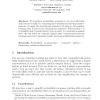Free Online Productivity Tools
i2Speak
i2Symbol
i2OCR
iTex2Img
iWeb2Print
iWeb2Shot
i2Type
iPdf2Split
iPdf2Merge
i2Bopomofo
i2Arabic
i2Style
i2Image
i2PDF
iLatex2Rtf
Sci2ools
121
Voted
PADL
2016
Springer
2016
Springer
Simplifying Probabilistic Programs Using Computer Algebra
We transform probabilistic programs to run more efficiently and read more easily, by composing three semantics-preserving transformations: (1) apply the denotational semantics; (2) improve the resulting integral; then (3) invert the denotational semantics. Whereas step 1 is a straightforward transformation from monadic to continuation-passing style, the rest builds on computer algebra: step 2 reorders and performs integrals, and step 3 represents density functions as differential operators.
Related Content
| Added | 08 Apr 2016 |
| Updated | 08 Apr 2016 |
| Type | Journal |
| Year | 2016 |
| Where | PADL |
| Authors | Jacques Carette, Chung-chieh Shan |
Comments (0)

